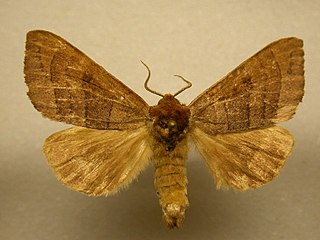Clostera paraphora is a species of moth in the family Notodontidae. It was first described by Harrison Gray Dyar Jr. in 1921 and it is found in North America.
Condica temecula is a species of moth in the family Noctuidae. It was first described by William Barnes in 1905 and it is found in North America.
Clostera apicalis, the apical prominent or red-marked tentmaker, is a species of moth in the family Notodontidae. It was first described by Francis Walker in 1855 and it is found in North America.
Ursia noctuiformis is a species of moth in the family Notodontidae. It was first described by William Barnes and James Halliday McDunnough in 1911 and it is found in North America.
Dichagyris socorro is a species of cutworm or dart moth in the family Noctuidae. It was first described by William Barnes in 1904 and it is found in North America.
Aleptina aleptivoides is a species of owlet moth in the family Noctuidae first described by William Barnes and James Halliday McDunnough in 1912. It is found in North America.

Datana angusii, or Angus's datana moth, is a species of moth in the family Notodontidae. It was first described by Augustus Radcliffe Grote and Coleman Townsend Robinson in 1866 and it is found in North America.
Tarache cora is a species of bird-dropping moth in the family Noctuidae. It was first described by William Barnes and James Halliday McDunnough in 1918 and it is found in North America.
Sympistis astrigata is a species of moth in the family Noctuidae. It was first described by William Barnes and James Halliday McDunnough in 1912 and it is found in North America.
Xylena brucei, or Bruce's swordgrass moth, is a species of cutworm or dart moth in the family Noctuidae. It is found in North America.
Anarta inconcinna is a species of cutworm or dart moth in the family Noctuidae. It was first described by Smith in 1888 and it is found in North America.
Cryphia flavidior is a species of moth in the family Noctuidae. It was first described by William Barnes and James Halliday McDunnough in 1911 and it is found in North America.
Clostera inornata is a species of moth in the family Notodontidae. It was first described by Neumögen in 1882 and it is found in North America.
Deinopa angitia is a species of owlet moths in the family Erebidae. It is found in Central America and North America.
Zale bethunei, or Bethune's zale, is a species of owlet moths in the family Erebidae. It is found in North America.
Lacinipolia aileenae is a moth genus or species of cutworm or dart moth in the family Noctuidae. It is found in North America.
Lacinipolia buscki is a species of cutworm or dart moth in the family Noctuidae first described by William Barnes and Foster Hendrickson Benjamin in 1927. It is found in Australia and North America.
Lacinipolia spiculosa is a species of cutworm or dart moth in the family Noctuidae. It is found in North America.
Lineostriastiria hutsoni is a species of owlet moth in the family Noctuidae. It is found in North America.
Clostera strigosa, the striped chocolate-tip or drab tent-maker moth, is a species of moth in the family Notodontidae. It was first described by Augustus Radcliffe Grote in 1882 and it is found in North America.
